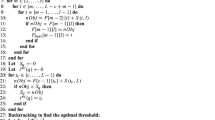Abstract
With a focus on complex environments, the present paper describes a new algorithm in rigid and non-rigid object tracking through color feature. Object tracking in these environments is taken into consideration as real-time applications, such as manufacturing, surveillance and monitoring, smart rooms, and so on, where partial or full occlusion sensibly occurs. As is obvious, the best color-based object tracking algorithm is now known, as the mean shift (MS) iterative procedure, to find the location of an object in image sequences. The algorithm performance is not unfortunately acceptable once objects in complex environments need to be tracked. In fact, the main aim of the present research is to improve the MS tracking algorithm, by proposing an improved convex kernel function, which is now realized in association with the Kalman filter approach (KFA). In the algorithm proposed here, the KFA is employed to solve the full occlusion problems since the speed for the objects is constant. Subsequently, the present investigated robust kernel function has been designed to dominate the low saturation and partial occlusion problems.
Similar content being viewed by others
References
Motavalli S (1991) A part image reconstruction system for reverse engineering of design modifications. J Manuf Syst 10(5):383–395
Cheng-Jin D, Da-Wen S (2004) Recent developments in the applications of image processing techniques for food quality evaluation. Trends Food Sci Tech 15(5):230–249
Demant C, Streicher-Abdel B, Waszkewit P (1999) Industrial image processing: visual quality control in manufacturing. Springer, Berlin. ISBN 3-540-66410-6
Klein HM, Schneider W, Alzen G, Voy ED, Günther RW (1992) Pediatric craniofacial surgery: comparison of milling and stereolithography for 3D model manufacturing. Pediatr Radiol 22(6):458–460. doi:10.1007/BF02013512
Rohrer MW (2000) Seeing is believing: the importance of visualization in manufacturing simulation. IEEE Proceedings of Simulation Conference, USA, 10.1109/WSC.2000.899087, vol. 2, pp. 1211–1216
Hollister SJ, Levy RA, Chu T-M, Halloran JW, Feinberg SE (2000) An image-based approach for designing and manufacturing craniofacial scaffolds. Int J Oral Maxillofac Surg 29(1):67–71
Mazinan AH, Amir‐Latifi A (2012) Improvement of mean shift tracking performance using a convex kernel function and extracting motion information. Comput Electr Eng (in press)
Comaniciu D, Ramesh V, Meer P (2000) Real-time tracking of non-rigid objects using mean shift. IEEE Conference on Computer Vision and Pattern Recognition 2:142–149
Liu H, Yu Z, Zha H, Zou Y, Zhang L (2009) Robust human tracking based on multi-cue integration and mean-shift. Pattern Recogn Lett 30(9):827–837
Sanjeev M, Maskell S, Gordon N, Clapp T (2002) A tutorial on particle filters for online nonlinear-non-Gaussian Bayesian tracking. IEEE Trans Signal Process 50(2):174–188
Comaniciu D, Meer P (2002) Mean shift: a robust approach toward feature space analysis. IEEE Trans Pattern Anal Mach Intell 24(5):603–619
Li S, Chang H, Zhu C (2010) Adaptive pyramid mean shift for global real-time visual tracking. Image Vision Comput 28(3):424–437
Leichter I, Lindenbaum M, Rivlin E (2010) Mean shift tracking with multiple reference color histograms. Comput Vis Image Understand 114:400–408
Maghami M, Zoroofi RA, Araabi BN, Shiva M, Vahedi E (2007) Kalman filter tracking for facial expression recognition using noticeable feature selection. International Conference on Intelligent and Advanced Systems, Kuala Lumpur, Malaysia, pp. 587–590
Welch G, Bishop G (2006) An introduction to the Kalman filter. Department of Computer Science University of North Carolina at Chapel Hill, July
Author information
Authors and Affiliations
Corresponding author
Rights and permissions
About this article
Cite this article
Mazinan, A.H., Amir-Latifi, A. A new algorithm to rigid and non-rigid object tracking in complex environments. Int J Adv Manuf Technol 64, 1643–1651 (2013). https://doi.org/10.1007/s00170-012-4129-9
Received:
Accepted:
Published:
Issue Date:
DOI: https://doi.org/10.1007/s00170-012-4129-9




